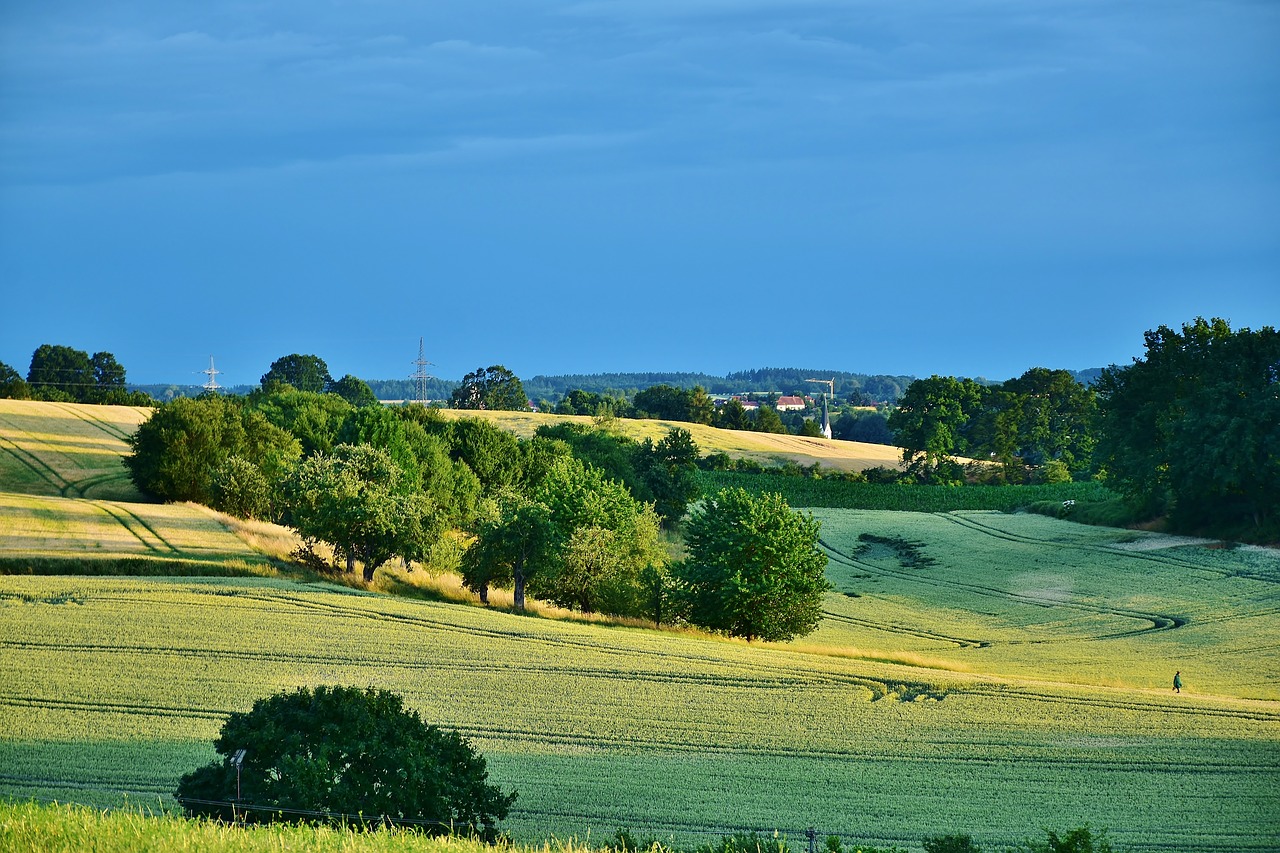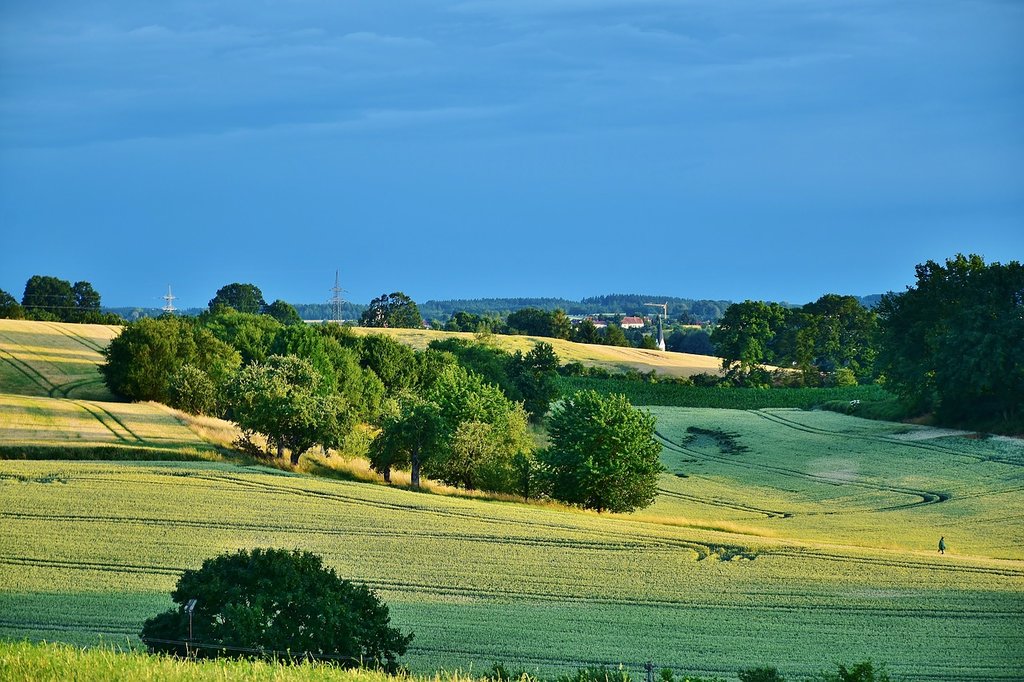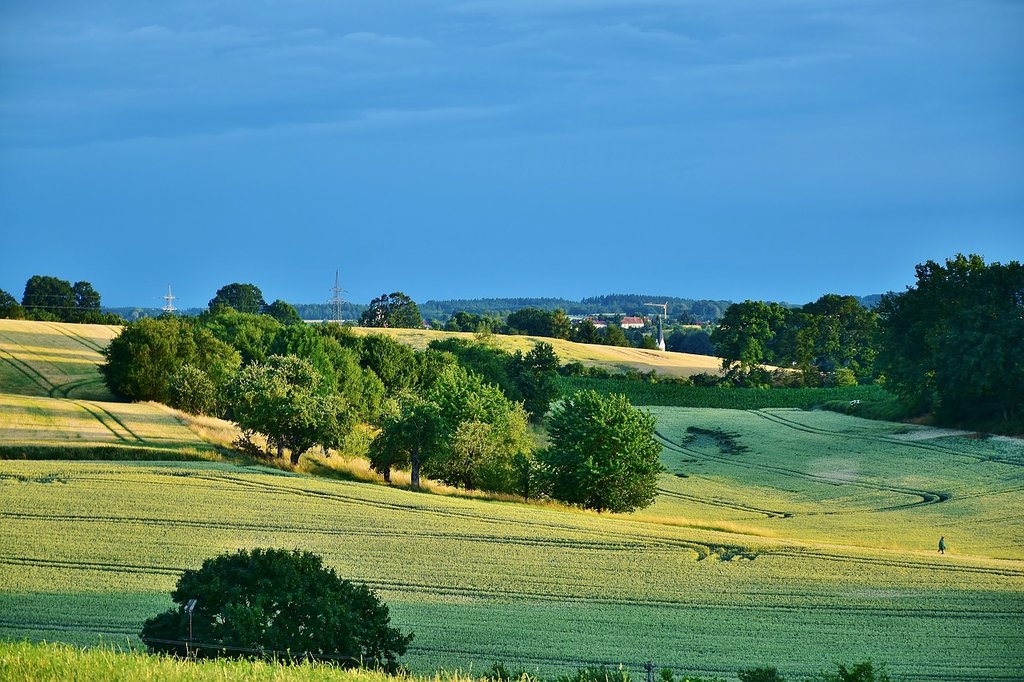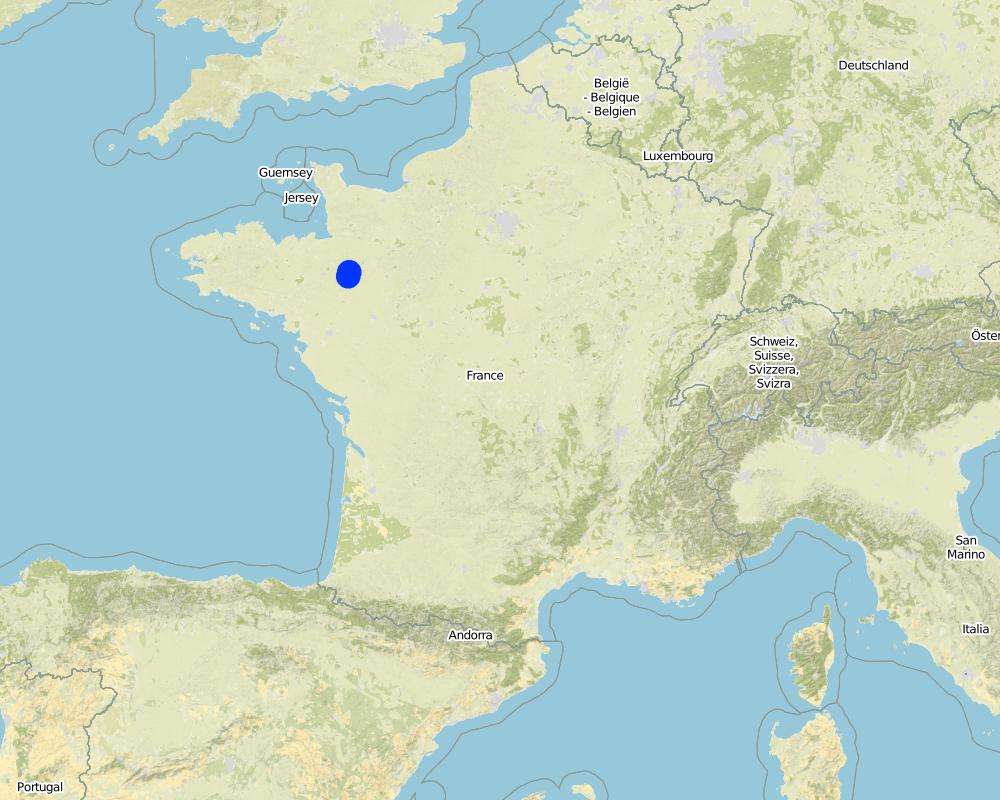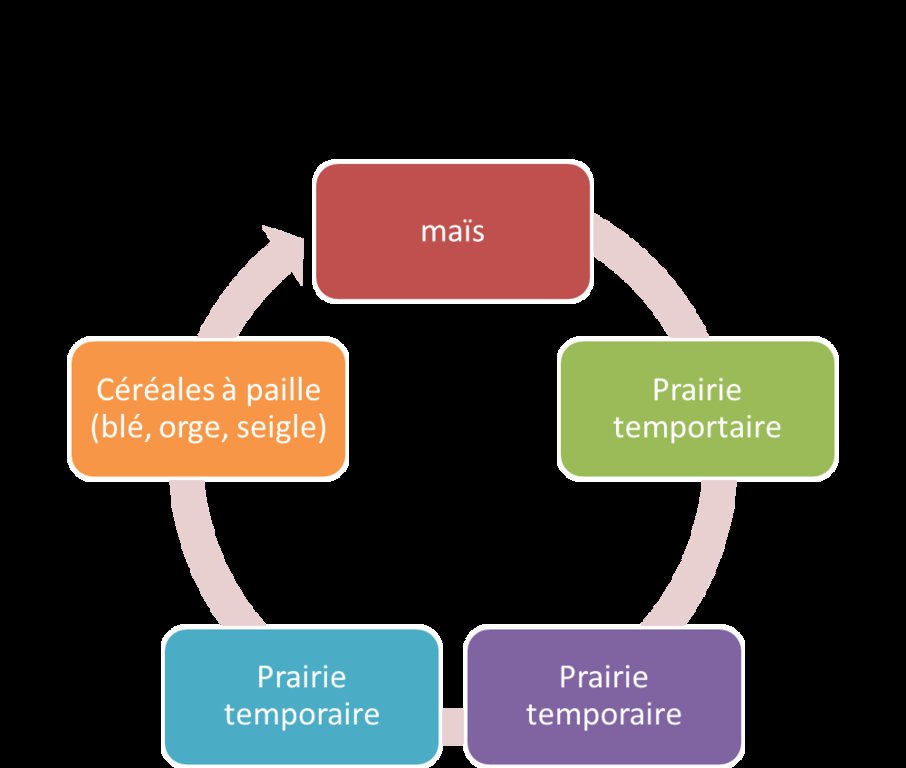Rotation des cultures [France]
- Creation:
- Update:
- Compiler: Julie Lemesle
- Editor: –
- Reviewers: Ursula Gaemperli, Gudrun Schwilch, Alexandra Gavilano
technologies_3167 - France
View sections
Expand all Collapse all1. General information
1.2 Contact details of resource persons and institutions involved in the assessment and documentation of the Technology
Key resource person(s)
land user:
Name of project which facilitated the documentation/ evaluation of the Technology (if relevant)
Interactive Soil Quality assessment in Europe and China for Agricultural productivity and Environmental Resilience (EU-iSQAPER)1.3 Conditions regarding the use of data documented through WOCAT
When were the data compiled (in the field)?
04/09/2017
The compiler and key resource person(s) accept the conditions regarding the use of data documented through WOCAT:
Ja
1.4 Declaration on sustainability of the described Technology
Is the Technology described here problematic with regard to land degradation, so that it cannot be declared a sustainable land management technology?
Nee
2. Description of the SLM Technology
2.1 Short description of the Technology
Definition of the Technology:
Plusieurs cultures espacées dans le temps sur la même parcelle. Enchaînement réfléchi et anticipé des différentes cultures d'une année à l'autre sur la même parcelle.
2.2 Detailed description of the Technology
Description:
1. La rotation des cultures est appliqué sur toute les parcelles de la ferme, dans les zones de polycultures élevage semi-bocagère en climat océanique avec un sol bon à moyen et des moyens agricoles opérationnels facilement accessibles.
2. Les principales caractéristiques de la rotation des cultures sont:
-enchainement optimum des cultures d'une année sur l'autre sur une même parcelle
3. Les objectifs et les fonctions de la rotation des cultures sont
-optimiser le potentiel des sols et des cultures
-limiter l'appauvrissement des sols
-limiter le développement des adventices et des ravageurs
-obtenir une meilleure récolte
-faire perdurer l'utilisation du sol par l'humain
4. Une des activités les plus importantes dans la rotation des cultures est le suivi parcellaire ( l'anticipation des futurs cultures, ici au moins une année à l'avance).
Un travail du sol régulier avec intrant du type fumier, composté et carbonate de chaux ( si nécessaire) aide pérenniser la rotation des sols.
Si la parcelle n'est pas en herbe, le travail du sol aura lieu deux fois par an.
Un assolement typique dans la zone du cas d'étude est maïs - céréales à paille - prairie.
5. Faire bénéficier les cultures entres elles ex: luzerne ou chicorée, plantes qui font des racines jusqu'à 1 mètre de profondeur et qui résistent bien au manque d'eau. Elles jouent donc aussi un rôle dans la structure du sol. De plus la luzerne permet d'enrichir le sol en azote.
Une des avantages de la rotation des cultures est l'augmentation du rendement. Dans le cas de la culture du maïs, si il est cultivé suite à un pâturage, il donnera un meilleur rendement.
6. Inconvénient: Nécessite plus de travail en comparaison d'une monoculture type pâturage.
Inconvénient pour un agriculteur conventionnel:
Dans le cas d'un céréalier conventionnel, il doit varier dans ses cultures les espèces et les familles végétales. C'est donc une contrainte pour lui.
Avantage principale apporte un meilleur rendement et apporte une variabilité de culture et d'alimentation pour les vaches notamment culture d'hiver tel que le maïs et la betterave
2.3 Photos of the Technology
2.5 Country/ region/ locations where the Technology has been applied and which are covered by this assessment
Country:
France
Region/ State/ Province:
Bretagne/France/Ille et Vilaine
Further specification of location:
Argentré du Plessis
Map
×2.6 Date of implementation
If precise year is not known, indicate approximate date:
- 10-50 years ago
2.7 Introduction of the Technology
Specify how the Technology was introduced:
- as part of a traditional system (> 50 years)
3. Classification of the SLM Technology
3.1 Main purpose(s) of the Technology
- improve production
- reduce, prevent, restore land degradation
- conserve ecosystem
- preserve/ improve biodiversity
- create beneficial economic impact
3.2 Current land use type(s) where the Technology is applied

Cropland
- Annual cropping
Main crops (cash and food crops):
Mais, céréales à paille, prairie
3.3 Further information about land use
Water supply for the land on which the Technology is applied:
- rainfed
Number of growing seasons per year:
- 2
Livestock density (if relevant):
1 vache à l'hectare
3.4 SLM group to which the Technology belongs
- rotational systems (crop rotation, fallows, shifting cultivation)
3.5 Spread of the Technology
Specify the spread of the Technology:
- evenly spread over an area
If the Technology is evenly spread over an area, indicate approximate area covered:
- < 0.1 km2 (10 ha)
Comments:
Que se soit des agriculteurs bio ou conventionnels, la majorité des agriculteurs utilisent la rotation des sols en Ille et Vilaine. De plus, la couverture des sols est obligatoire en hiver en Ille et Vilaine.
3.6 SLM measures comprising the Technology

agronomic measures
- A1: Vegetation/ soil cover
- A2: Organic matter/ soil fertility
3.7 Main types of land degradation addressed by the Technology

soil erosion by water
- Wt: loss of topsoil/ surface erosion
- Wg: gully erosion/ gullying
- Wr: riverbank erosion

biological degradation
- Bc: reduction of vegetation cover
- Bl: loss of soil life
3.8 Prevention, reduction, or restoration of land degradation
Specify the goal of the Technology with regard to land degradation:
- prevent land degradation
- reduce land degradation
4. Technical specifications, implementation activities, inputs, and costs
4.1 Technical drawing of the Technology
4.2 Technical specifications/ explanations of technical drawing
Schéma d'une rotation typique de la zone sur 5 ans.
Si la parcelle n'est pas en herbe, le travail du sol aura lieu deux fois par an. Un
assolement typique dans la zone du cas d'étude est maïs - céréales à paille - prairie.
4.3 General information regarding the calculation of inputs and costs
Specify how costs and inputs were calculated:
- per Technology area
Indicate size and area unit:
80 hectares en rotation de cultures
other/ national currency (specify):
euro
Indicate average wage cost of hired labour per day:
115 euros
4.5 Costs and inputs needed for establishment
Comments:
Pâturage: 400 euros l'hectare globale pendant 5 ans
Maïs: 500 euros, 1 fois
Blé: 200 euros (moitié autoproduction de semence), 1 fois
puis retour au pâturage
4.6 Maintenance/ recurrent activities
| Activity | Type of measure | Timing/ frequency | |
|---|---|---|---|
| 1. | préparation du sol | Agronomic | avril |
| 2. | semis | Agronomic | mai |
| 3. | entretien des cultures | Agronomic | mai |
| 4. | récolte | Agronomic | septembre |
| 5. | semis | Agronomic | novembre |
| 6. | entretien des cultures | Agronomic | novembre |
| 7. | récolte | Agronomic | aout |
4.7 Costs and inputs needed for maintenance/ recurrent activities (per year)
If possible, break down the costs of maintenance according to the following table, specifying inputs and costs per input. If you are unable to break down the costs, give an estimation of the total costs of maintaining the Technology:
300.0
Comments:
Pâturage: 400 euros l'hectare globale pendant 5 ans
Maïs: 500 euros, 1 fois
Blé: 200 euros (moitié autoproduction de semence), 1 fois
puis retour au pâturage
4.8 Most important factors affecting the costs
Describe the most determinate factors affecting the costs:
La semence
Travaille et semi du sol
5. Natural and human environment
5.1 Climate
Annual rainfall
- < 250 mm
- 251-500 mm
- 501-750 mm
- 751-1,000 mm
- 1,001-1,500 mm
- 1,501-2,000 mm
- 2,001-3,000 mm
- 3,001-4,000 mm
- > 4,000 mm
Specify average annual rainfall (if known), in mm:
650.00
Agro-climatic zone
- sub-humid
Climat tempéré océanique doux, avec un hiver doux et un été frais.
5.2 Topography
Slopes on average:
- flat (0-2%)
- gentle (3-5%)
- moderate (6-10%)
- rolling (11-15%)
- hilly (16-30%)
- steep (31-60%)
- very steep (>60%)
Landforms:
- plateau/plains
- ridges
- mountain slopes
- hill slopes
- footslopes
- valley floors
Altitudinal zone:
- 0-100 m a.s.l.
- 101-500 m a.s.l.
- 501-1,000 m a.s.l.
- 1,001-1,500 m a.s.l.
- 1,501-2,000 m a.s.l.
- 2,001-2,500 m a.s.l.
- 2,501-3,000 m a.s.l.
- 3,001-4,000 m a.s.l.
- > 4,000 m a.s.l.
Indicate if the Technology is specifically applied in:
- not relevant
5.3 Soils
Soil depth on average:
- very shallow (0-20 cm)
- shallow (21-50 cm)
- moderately deep (51-80 cm)
- deep (81-120 cm)
- very deep (> 120 cm)
Soil texture (topsoil):
- medium (loamy, silty)
Soil texture (> 20 cm below surface):
- medium (loamy, silty)
Topsoil organic matter:
- medium (1-3%)
5.4 Water availability and quality
Ground water table:
on surface
Availability of surface water:
medium
Water quality (untreated):
good drinking water
Is water salinity a problem?
Nee
Is flooding of the area occurring?
Nee
5.5 Biodiversity
Species diversity:
- medium
Habitat diversity:
- medium
5.6 Characteristics of land users applying the Technology
Sedentary or nomadic:
- Sedentary
Market orientation of production system:
- commercial/ market
Off-farm income:
- less than 10% of all income
Relative level of wealth:
- average
Individuals or groups:
- individual/ household
Level of mechanization:
- mechanized/ motorized
Gender:
- women
- men
Age of land users:
- middle-aged
5.7 Average area of land owned or leased by land users applying the Technology
- < 0.5 ha
- 0.5-1 ha
- 1-2 ha
- 2-5 ha
- 5-15 ha
- 15-50 ha
- 50-100 ha
- 100-500 ha
- 500-1,000 ha
- 1,000-10,000 ha
- > 10,000 ha
Is this considered small-, medium- or large-scale (referring to local context)?
- medium-scale
5.8 Land ownership, land use rights, and water use rights
Land ownership:
- individual, titled
Land use rights:
- individual
Water use rights:
- communal (organized)
- individual
5.9 Access to services and infrastructure
health:
- poor
- moderate
- good
education:
- poor
- moderate
- good
technical assistance:
- poor
- moderate
- good
employment (e.g. off-farm):
- poor
- moderate
- good
markets:
- poor
- moderate
- good
energy:
- poor
- moderate
- good
roads and transport:
- poor
- moderate
- good
drinking water and sanitation:
- poor
- moderate
- good
financial services:
- poor
- moderate
- good
- poor
- moderate
- good
6. Impacts and concluding statements
6.1 On-site impacts the Technology has shown
Socio-economic impacts
Production
crop quality
Comments/ specify:
Grâce aux rotations, les cultures sont moins sensibles (maladies, ravageurs)
product diversity
Income and costs
diversity of income sources
6.4 Cost-benefit analysis
How do the benefits compare with the establishment costs (from land users’ perspective)?
Short-term returns:
positive
Long-term returns:
positive
How do the benefits compare with the maintenance/ recurrent costs (from land users' perspective)?
Short-term returns:
slightly positive
Long-term returns:
positive
6.5 Adoption of the Technology
- 10-50%
Of all those who have adopted the Technology, how many have did so spontaneously, i.e. without receiving any material incentives/ payments?
- 10-50%
Comments:
La région Bretagne subventionne le matériel qui favorise l'implantation et la récolte de l'herbe.
6.6 Adaptation
Has the Technology been modified recently to adapt to changing conditions?
Nee
6.7 Strengths/ advantages/ opportunities of the Technology
| Strengths/ advantages/ opportunities in the land user’s view |
|---|
| Meilleur rendement qu'en monocutlure |
| Diversité des sources alimentaires pour les animaux, équilibre des différentes cultures |
| Limiter les risques d'une mauvaise récolte sur une culture dans le cas d'une monoculture |
| Strengths/ advantages/ opportunities in the compiler’s or other key resource person’s view |
|---|
| Limiter les risques d'une mauvaise récolte sur une culture dans le cas d'une monoculture |
6.8 Weaknesses/ disadvantages/ risks of the Technology and ways of overcoming them
| Weaknesses/ disadvantages/ risks in the land user’s view | How can they be overcome? |
|---|---|
| Nécessite d'avantage de travail et d'avantage de connaissance pour la mise en place de la rotation des cultures pour l'entretien de la rotation des cultures et nécessite l'achat de matériel spécifique. |
| Weaknesses/ disadvantages/ risks in the compiler’s or other key resource person’s view | How can they be overcome? |
|---|---|
| Nécessite d'avantage de travail et d'avantage de connaissance pour la mise en place de la rotation des cultures pour l'entretien de la rotation des cultures et nécessite l'achat de matériel spécifique. |
7. References and links
7.1 Methods/ sources of information
- interviews with land users
Christophe Lemesle
Jean Pierre Lemesle
Links and modules
Expand all Collapse allLinks
No links
Modules
No modules


